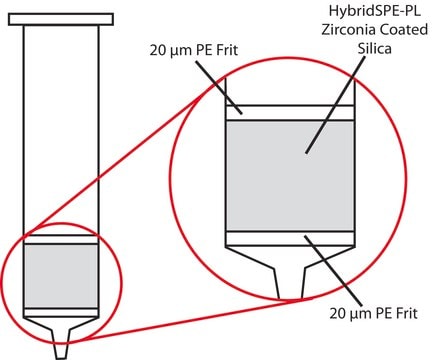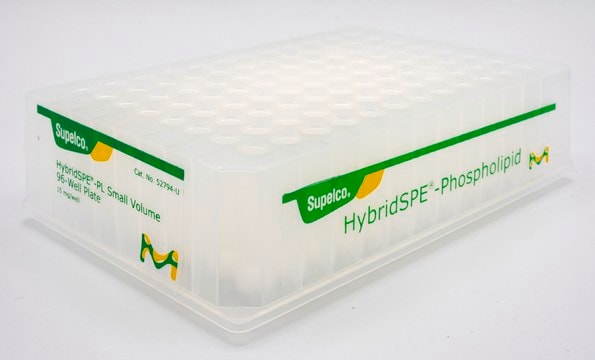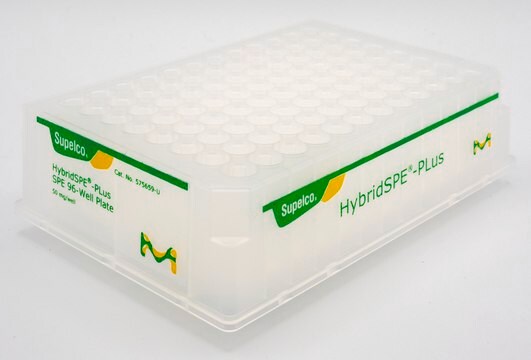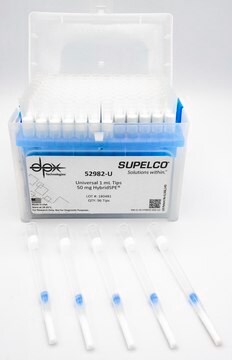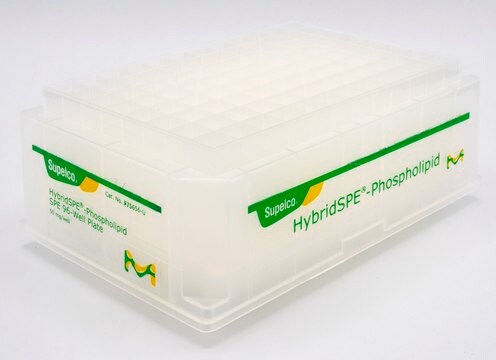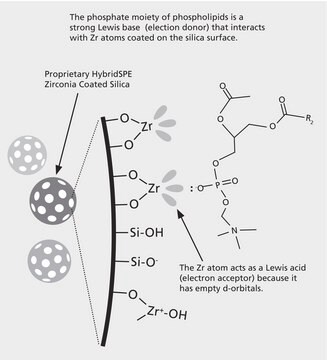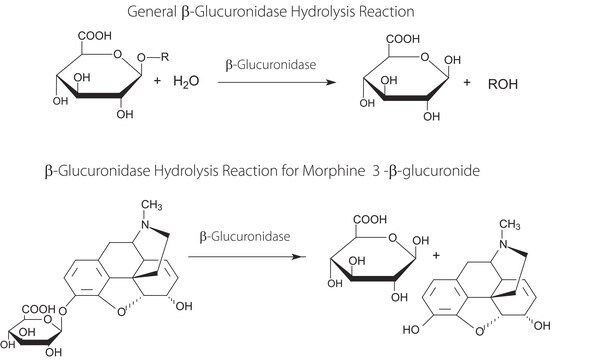55276-U
HybridSPE®-Phospholipid solid phase extraction (SPE) Cartridge
Cartridge, bed wt. 30 mg, volume 1 mL, pk of 200, polypropylene material (hardware), PE frit (20 μm)
Sinónimos:
HybridSPE (phospholipid and protein removal) SPE cartridge tube, 6 mL
About This Item
Productos recomendados
Nombre del producto
HybridSPE®-Phospholipid, Cartridge, bed wt. 30 mg, volume 1 mL, pk of 200, polypropylene material (hardware), PE frit (20 μm)
material
PE frit (20 μm)
polypropylene hardware
Quality Level
composition
bed wt., 30 mg
packaging
pk of 200
technique(s)
solid phase extraction (SPE): suitable
volume
1 mL
matrix active group
zirconia-based phase
¿Está buscando productos similares? Visita Guía de comparación de productos
Categorías relacionadas
General description
The "In-well" and "In-cartridge" precipitation methods are available for the HybridSPE-Phospholipid 96-well version and HybridSPE-Phospholipid Ultra cartridge in which biological plasma/serum is first added to either the well or cartridge, followed by acidified acetonitrile (precipitation agent). After a brief mixing/vortexing step, vacuum is applied. Because the 96-well and Ultra cartridge versions contain a series of low porosity hydrophobic filters/frits, the packed-bed filter/frit assembly acts as a depth filter facilitating the concurrent removal of both phospholipids and precipitated proteins during the extraction process. Standard HybridSPE-Phospholipid cartridges require an "off-line" precipitation method.
Application
- Less is more: a methodological assessment of extraction techniques for per- and polyfluoroalkyl substances (PFAS) analysis in mammalian tissues.: This study evaluates various extraction techniques, including the use of HybridSPE-Phospholipid, for analyzing PFAS in mammalian tissues. The research highlights the importance of effective phospholipid removal to ensure accurate PFAS quantification (Mertens et al., 2023).
- Rapid analysis of 65 pharmaceuticals and 7 personal care products in plasma and whole-body tissue samples of fish using acidic extraction, zirconia-coated silica cleanup, and liquid chromatography-tandem mass spectrometry.: The study includes HybridSPE-Phospholipid as part of the cleanup process, demonstrating its efficiency in removing phospholipids to improve the detection of pharmaceuticals and personal care products in biological samples (Tanoue et al., 2020).
- Multi LC-MS/MS and LC-HRMS Methods for Determination of 24 Mycotoxins including Major Phase I and II Biomarker Metabolites in Biological Matrices from Pigs and Broiler Chickens.: This research utilizes HybridSPE-Phospholipid for the cleanup of biological matrices, enhancing the accuracy of mycotoxin detection by effectively removing interfering phospholipids (Lauwers et al., 2019).
- Effective phospholipid removal from plasma samples by solid phase extraction with the use of copper (II) modified silica gel cartridges.: The study compares various phospholipid removal techniques, highlighting the performance of HybridSPE-Phospholipid in achieving high phospholipid removal efficiency from plasma samples (Flieger et al., 2017).
- Liquid chromatography mass spectrometry determination of perfluoroalkyl acids in environmental solid extracts after phospholipid removal and on-line turbulent flow chromatography purification.: The research demonstrates the application of HybridSPE-Phospholipid in the removal of phospholipids from environmental solid extracts, facilitating the accurate measurement of perfluoroalkyl acids (Mazzoni et al., 2016).
Features and Benefits
- Merges the simplicity of protein precipitation and the selectivity of SPE via the targeted removal of phospholipids
- Reduce ion-suppression through the complete removal of phospholipids and precipitated proteins
- 2-3 step generic procedure
- Minimal to no method development
- Available in 96-well and 1 mL cartridge dimensions
Legal Information
Storage Class
11 - Combustible Solids
wgk_germany
WGK 3
flash_point_f
Not applicable
flash_point_c
Not applicable
Elija entre una de las versiones más recientes:
¿Ya tiene este producto?
Encuentre la documentación para los productos que ha comprado recientemente en la Biblioteca de documentos.
Artículos
We are presenting an article focusing on ion-suppression and phospholipid contamination and some of their major causes and difficulties.
Protocolos
A simple method to enrich phospholipids from plasma samples, involving a HybridSPE-PPT 96-well plate that both retains phospholipids and removes precipitated proteins.
Global Trade Item Number
| Número de referencia del producto (SKU) | GTIN |
|---|---|
| 55276-U | 4061833528334 |
| A7256-1G | 4061833383919 |
| A7256-5G | 4061833383926 |
| N-151-1ML | 4065269399810 |
Nuestro equipo de científicos tiene experiencia en todas las áreas de investigación: Ciencias de la vida, Ciencia de los materiales, Síntesis química, Cromatografía, Analítica y muchas otras.
Póngase en contacto con el Servicio técnico